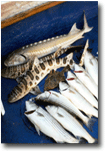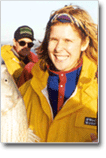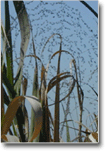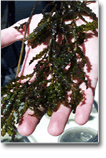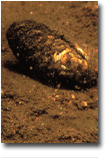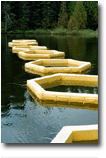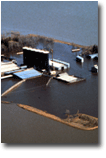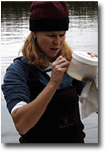| |
A.
Robin Stewart
Research Hydrologist
B.S. University of Victoria, Biology
Ph.D. University of Manitoba, Botany
arstewar@usgs.gov
Research Interests
My research focuses on understanding transport, fate and bioaccumulation
of trace metals, elements and organic contaminants in aquatic
systems. I have studied a range of contaminants including
trace elements (metals, Se, Hg) and organochlorine pesticides
(PCBs, DDT), in a variety of aquatic systems including lakes
and reservoirs, wetlands, estuaries and rivers, and in biota
ranging in size from zooplankton to diving ducks and sturgeon.
These diverse research interests have led me to a greater
understanding of how contaminants behave chemically in the
environment, interact with biological systems and manifest
their effects in nature. Each research area is of sufficient
importance and interest to continue dedicated research on
them; however, it is how they interact in a larger ecosystem
context that I find most intriguing. In the past, the goal
of understanding complex environmental problems in nature
was seen as unattainable. However, with new tools and combined
approaches from a variety of disciplines I believe we will
soon be able to develop ecosystem models that accurately depict
mechanisms of contamination at all levels of ecosystem organization.
It is only through this level of awareness that will we truly
be able to understand chemical stressors and protect our environment.
Selected publications:
Selenium and
mercury distribution in food webs of the San Francisco Bay-Delta:
Stewart, A.R., Saiki, M.K., Kuwabara,
J.S., Alpers, C.N., Marvin-DiPasquale, M., and Krabbenhoft,
D.P. Influence of plankton mercury dynamics and trophic pathways
on mercury concentrations of top predator fish of a mining-impacted
reservoir. Can.J.Fish.Aquat.Sci. 2008. In press.
Stewart,
AR, Luoma, SN, Schlekat, CE, Doblin, MA and Hieb, KA. 2004.
Food Web Pathway Determines How Selenium Affects Aquatic Ecosystems:
A San Francisco Bay Case Study. Environ.
Sci. Technol. 38(17):4519-4526.
Baines, S.B., N.S. Fisher, and A.R. Stewart.
2002. Assimilation of Se and trace metals from food in juvenile
striped bass. Limnol.
Oceanogr. 47: 646-655.
Stewart, A.R. and others. 2001. Applications
of stable isotopes research in understanding complex ecological
processes in the San Francisco Estuary. Interagency Ecological
Program for the San Francisco Estuary. IEP
Newsletter 14 (4): 27-32.
Fate
and transport of trace elements and organic chemicals during
the 1997 Red River flood:
Stewart, A.R., Stern,
G.A., Lockhart, W.L, Kidd, K.A., Salki, A.G., Stainton, M.P.,
Koczanski, K., Rosenberg, G.B., Savoie, D.A., Billeck, B.N.,
Wilkinson, P., and Muir, D.C.G. 2003. Assessing Trends in
Organochlorine Concentrations in Lake Winnipeg Fish Following
the 1997 Red River Flood. J.
Great Lakes Res. 29(2):332-354.
Stewart, A.R., Stern, G.A., Salki, A.,
Stainton, M.P., Lockhart, W.L., Billeck, B.N., Danell, R.,
Delaronde, J., Grift, N.P., Koczanski, K., MacHutcheon, A.,
Rosenberg, B., Savoie, D., Tenkula, D., Tomy, G., and Yarchewski,
A. 2000. Effects of the 1997 Red River flood on contaminant
transport and fate in southern Lake Winnipeg. International
Red River Basin Task Force. http://www.ijc.org/pdf/winnipegwaterquality.pdf
Bioavailability
and bioaccumulation of trace metals in Precambrian shield
lakes in association with Canada's Experimental Lakes Area:
Stewart, A.R. 1999. Accumulation
of cadmium by a freshwater mussel (Pyganodon grandis) is reduced
in the presence of other metals. Can.
J. Fish. Aquat. Sci. 56: 467-478.
Stewart, A.R. and Malley, D.F. 1999.
The effect of a metal mixture (Cu, Zn, Pb and Ni) on cadmium
bioavailability and accumulation by the freshwater macrophyte
Eriocaulon septangulare. Environ.
Toxicol. Chem. 18:436-447.
Stewart, A.R. 1998. Effect of a metal
mixture (Cu, Zn, Pb and Ni) on the bioavailability and bioaccumulation
of cadmium in natural systems. University of Manitoba, Winnipeg,
Manitoba.
Malley, D.F., A.R. Stewart and B.D. Hall.
1996. Uptake of methyl mercury by the floater mussel, Pyganodon
grandis (Bivalvia, Unionidae), caged in a flooded wetland.
Environ.
Tox. Chem. 15: 928-936.
|



